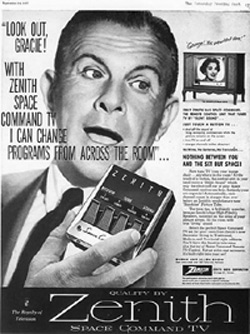 We can all thank Robert Adler for the ability to be complete couch potatoes while watching TV. Born December 4, 1913, Robert Adler held 180 patents for electronic devices but he is best known for having invented the first useable wireless television remote control.
We can all thank Robert Adler for the ability to be complete couch potatoes while watching TV. Born December 4, 1913, Robert Adler held 180 patents for electronic devices but he is best known for having invented the first useable wireless television remote control.
The first remote control known as “Lazy Bones” was developed in the 1950’s by Zenith. This remote used a cable that ran from the TV to the user. An idea for a wireless remote control was devised by fellow Zenith engineer Eugene Polley. This remote control used light beams to control the television. The problem was that when the television was in direct sunlight it would often turn on by itself. Continue reading “Nothing Between You and the TV But Space!”


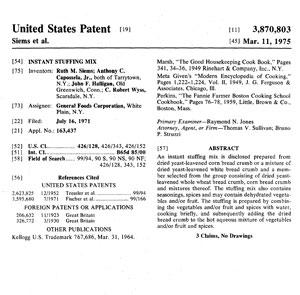 U.S. Patent No 3,870,803 was issued to General Foods on March 11, 1975 for Instant Stuffing Mix. Ruth Siems, Anthony C. Capossela Jr., John F. Halligan and C. Robert Wyss are listed as the inventors. The patent was based on the correct size of the bread crumb for successful rehydration. A bread crumb that is too small will turn into a soggy mess when water is added. If the crumb is too large, the water will not soften the crumb.
U.S. Patent No 3,870,803 was issued to General Foods on March 11, 1975 for Instant Stuffing Mix. Ruth Siems, Anthony C. Capossela Jr., John F. Halligan and C. Robert Wyss are listed as the inventors. The patent was based on the correct size of the bread crumb for successful rehydration. A bread crumb that is too small will turn into a soggy mess when water is added. If the crumb is too large, the water will not soften the crumb.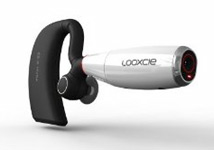 Looxcie was invented by a man who was tired of dealing with a video camera while trying to record a children’s birthday party. Instead of being stuck behind the camera, it would be possible to participate in events while capturing the moments on video at the same time. Looxcie is a Bluetooth enabled video camera that you wear over you ear which uses a smart phone as the view finder. You line up the camera with what you want to video, put your phone away and enjoy the moment while still recording.
Looxcie was invented by a man who was tired of dealing with a video camera while trying to record a children’s birthday party. Instead of being stuck behind the camera, it would be possible to participate in events while capturing the moments on video at the same time. Looxcie is a Bluetooth enabled video camera that you wear over you ear which uses a smart phone as the view finder. You line up the camera with what you want to video, put your phone away and enjoy the moment while still recording. 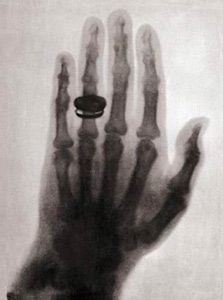 This week in 1895, a monumental advancement in medical technology was made by accident in a German lab.
This week in 1895, a monumental advancement in medical technology was made by accident in a German lab. The first program-controlled computer machine was built in the inventor’s parent’s living room. The Z1 was assembled between 1936 and 1938 by a German man with no background in electronics. Konrad Zuse, a civil engineer, quit his job at an aviation company to build his device.
The first program-controlled computer machine was built in the inventor’s parent’s living room. The Z1 was assembled between 1936 and 1938 by a German man with no background in electronics. Konrad Zuse, a civil engineer, quit his job at an aviation company to build his device.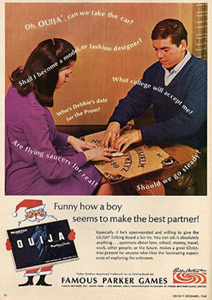 Believe it or not, there are numerous patents for the most popular device supposedly used to communicate with those in the spirit world. The device wasn’t really invented by any of the patent holders, instead it was refined. A Ouija board is used by putting your fingertips on the planchette or indicator and allowing the spirits to guide the planchette around the board. This idea was not new to the Ouija board. “Automatic writing” which was practiced by the ancient Chinese was a process of producing writing utilizing a planchette. Supposedly, the hands of the writer were guided by forces beyond themselves.
Believe it or not, there are numerous patents for the most popular device supposedly used to communicate with those in the spirit world. The device wasn’t really invented by any of the patent holders, instead it was refined. A Ouija board is used by putting your fingertips on the planchette or indicator and allowing the spirits to guide the planchette around the board. This idea was not new to the Ouija board. “Automatic writing” which was practiced by the ancient Chinese was a process of producing writing utilizing a planchette. Supposedly, the hands of the writer were guided by forces beyond themselves.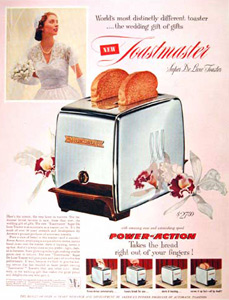 What was the greatest thing since before sliced bread? Why burnt toast, of course!
What was the greatest thing since before sliced bread? Why burnt toast, of course!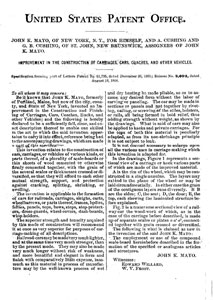 Although plywood is considered a modern building material, its origin can be traced to ancient times. Remnants of plywood have been found in Ancient Egyptian tombs. There was a shortage of fine wood in Egypt. In order to save the higher quality wood for the exterior of furniture and other decorative products, the Egyptians glued thin sheets of the high quality wood to the lower quality more available wood. Ancient Chinese were known to use a similar technique for furniture. In the 1600 and 1700’s, the British and French experimented with different types of plywood.
Although plywood is considered a modern building material, its origin can be traced to ancient times. Remnants of plywood have been found in Ancient Egyptian tombs. There was a shortage of fine wood in Egypt. In order to save the higher quality wood for the exterior of furniture and other decorative products, the Egyptians glued thin sheets of the high quality wood to the lower quality more available wood. Ancient Chinese were known to use a similar technique for furniture. In the 1600 and 1700’s, the British and French experimented with different types of plywood.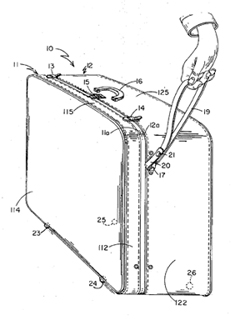 It has only been for the last forty years that traveling did not have to mean a sore back from carrying your luggage. Before 1970, luggage had to be carried. Suitcases did not have wheels. This month, wheeled luggage celebrates its 40th anniversary. Bernard Sadow is the man who made traveling with ten pairs of shoes and enough clothes for a month much easier.
It has only been for the last forty years that traveling did not have to mean a sore back from carrying your luggage. Before 1970, luggage had to be carried. Suitcases did not have wheels. This month, wheeled luggage celebrates its 40th anniversary. Bernard Sadow is the man who made traveling with ten pairs of shoes and enough clothes for a month much easier.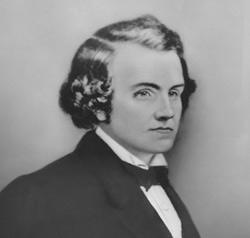 John Gorrie is considered the father of refrigeration and air conditioning. Gorrie’s medical research involved the study of yellow fever. At the time of his research, it was widely believed that bad air was the cause of many diseases. Gorrie also noticed that outbreaks of yellow fever were less frequent in the winter. He was convinced that cold was a healer. This led Gorrie to cool the sickrooms of his patients to reduce fever and make them more comfortable.
John Gorrie is considered the father of refrigeration and air conditioning. Gorrie’s medical research involved the study of yellow fever. At the time of his research, it was widely believed that bad air was the cause of many diseases. Gorrie also noticed that outbreaks of yellow fever were less frequent in the winter. He was convinced that cold was a healer. This led Gorrie to cool the sickrooms of his patients to reduce fever and make them more comfortable.